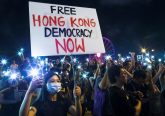Today is the 28th day of the mass protests that have gripped Chile; it is also the one-year anniversary of the killing of Camilo Catrillanca, a young Mapuche leader, by Chilean police. A year ago, popular mobilisation of the scale witnessed today in Chile seemed almost unimaginable, especially after I spent months in the Araucanía region in Southern Chile (or the Wallmapu to the Mapuche), where anything but the most innocuous collective organising has been heavily repressed. While simmering discontent was mixed with fear in the South, in the capital it seemed the frustrations of the student movement (see for example Donoso, 2013) and the return of the right-wing Sebastián Piñera to the presidency in 2018 made an eruption of mass mobilisation rather unlikely. What is happening right now in Chile challenges, then, the prominent argument within the social movement literature that protest only matters when political opportunities are already favourable (Amenta, 2014; Giugni, 2007; Meyer, 2004).
Sparked by student protests against a fare rise of Santiago’s metro system on October 18th, mass mobilisation in Chile quickly became about socio-economic inequality (according to latest World Bank data, Chile is the 26th most unequal country in the world)[1] and the lack of institutional reforms since the end of the dictatorship (substantial parts of the Constitution date back to Pinochet’s reforms). In fact, the unrelenting call for a new Constitution hasbecome an overarching and unifying goal of student, popular and indigenous activists. On November 11th, the government announced plans for a constitutional congress. Yet, this does not meet the demand for a bottom-up popular constitutional assembly, a demand which activists seem set to insist on.
These cross-sectional popular protests, which turned into a national strike, have been heavily repressed; at least 20 people have been killed, and Amnesty International has denounced Chile to the Inter-American Commission for human rights violations. Mass mobilisation shows little signs of abating, but it remains to be seen whether a truly bottom-up constitutional reform can be achieved. What is clear though is that the protests have already been able to force the Piñera government to make some concessions, such as the suspension of the fare increase and a full cabinet reshuffle.
Moreover, the reaction to the protests have shown ordinary Chileans just how repressive their state can be, something which previously had been mostly reserved for the Mapuche. An indigenous minority concentrated in the South, the Mapuche have long struggled and mobilised for greater autonomy, land redistribution, reserved seats in parliament, bilingual provision, and against plans of the Piñera administration to allow the individual sale of collectively–held land titles. Escalating confrontations with the Chilean state have almost completely decimated a historically fragmented Mapuche movement. While some groups have cooperated with the state, other have long resisted its encroachment and fought for greater recognition of their rights (Carruthers & Rodriguez, 2009; Pairican, 2015; Richards, 2010).

The indigenous Mapuche were never officially conquered by the Spanish, and were only forcibly incorporated into the Chilean state in 1881 in what is euphemistically known in Chile as the “pacification” of the Araucanía region. Relegated to at the beginning of the 20th century. In his seminal work Malon, Mapuche historian Fernando Pairicán recounts the aftermath of the late 19th century occupation and establishment of indigenous reserves (reducciones) in previously autonomous Mapuche territory. He cites a local professor that had described the plight of the Mapuche at that time.
“The new landowners are slowly appropriating themselves of indigenous lands, now legalised as reservations. The military, tasked with public order, flog the Mapuche for simply being suspected of theft, they trample them on horseback and indiscriminately injure women and children during their festivals and customary reunions”
(Pairican, 2015: 37)
This quote struck a sad chord with me, because when I visited Araucanía —or the Wallmapu—in both 2016 and 2018 for fieldwork. It seemed that even though more than 150 years had passed, some things remained the same. On November 14th, 2018, Camilo Catrillanca was killed by a militarized police squad ‘Comando Jungla’ in the community (lof) of Temucuicui, after the police had claimed that a car robbery had been reported and that they suspected the culprits to come from Mapuche communities near Ercilla.
Two days before Catrillanca’s killing, I had spoken to the first Mapuche council women of Ercilla. This town was one of the epicentres of the so-called conflict where forestry company trucks were set on fire in the late 1990s, mainly by the left-wing Mapuche activists of the Coordinadora Arauco Malleco (CAM) (Gaitán-Barrera & Azeez, 2018). She recounted how using suspected theft as a justification to harass communities was a daily occurrence. She also told me that the use of disruptive tactics by organisations such as the CAM, had resulted in increasingly heavy state repression, militarisation of the zone, and arrests of Mapuche leaders in the infamous HurricaneOperation. Indeed, I witnessed large numbers of militarised armoured vehicles driving around small countryside villages.
Two days later, Catrillanca’s death and the protests that followed—despite the usual heavy repression—the Mapuche struggle would finally reach international news as a struggle of indigenous people with internationally protected rights (see ILO1690), rather than ‘terrorists’. For years, the Chilean state has been applying Pinochet-era anti-terrorism legislation to Mapuche protest. It was this episode that shed a light on the plight of the Mapuche and the repressive state reaction. However, as long as state repression had been restricted to Mapuche mobilization, Chilean public opinion been supportive of heavy-handed responses and the security forces in general (Bonner, 2014).

Things appear to have changed though, now that repression of the country-wide protests has shown that you do not have to be Mapuche to suffer at the hands of Pinochet-inherited laws and security forces. This has created new levels of popular solidarity, with the Mapuche flag flying prominently at demonstrations. It has given the Mapuche movement an opportunity to engage in more disruptive tactics again; most spectacular has been tearing down statues of conquistadors in the Wallmapu. The photo below shows the head from a previously toppled conqueror’s statue in the hands of a Mapuche warrior, with the message: “New Constitution or Nothing.”

The multi-sectorial protests that have gripped the country in recent weeks were not instigated by the Mapuche movement (although many Mapuche students participated from the outset), but they have opened up space for Mapuche activists to organise, protest and disrupt more freely, after decades of repression and fragmentation. The newfound solidarity between the Mapuche and disaffected Chileans might be what is needed to finally reform Chilean politics from below.
My doctoral research on indigenous movements in Latin America finds that even under unfavourable political conditions, protest can have desired consequences when it can impose a high enough combination of material and symbolic costs (Krausova, 2018). The large-scale disruptive nature of the protests has certainly made the material costs high, and disruptive protest can have a direct impact in certain contexts (Biggs & Andrews, 2015; Kolb & Tarrow, 2007). However, my work shows that without the accompanying delegitimisation of targets, disruptive protest alone is unlikely to succeed. This has certainly been the case for the Mapuche, as they have struggled for decades without the repression they have suffered being widely considered illegitimate. Finally, it seems that protest in Chile is able to also impose high enough symbolic costs on the state to make a difference.
References
Amenta, E. (2014). How to Analyze the Influence of Movements. Contemporary Sociology: A Journal of Reviews, 43(1), 16-29.
Biggs, M., & Andrews, K. (2015). Protest Campaigns and Movement Success: Desegregating the South, 1960-61. American Sociological Review, 80(2), 416-443.
Bonner, M. D. (2014). Policing protest in Argentina and Chile. Boulder, Colorado: First Forum Press.
Carruthers, D., & Rodriguez, P. (2009). Mapuche Protest, Environmental Conflict and Social Movement Linkage in Chile. Third World Quarterly, 30(4), 743-760.
Gaitán-Barrera, A., & Azeez, G. K. (2018). Beyond recognition: autonomy, the state, and the Mapuche Coordinadora Arauco Malleco. Latin American and Caribbean Ethnic Studies, 13(2), 113-134. doi:10.1080/17442222.2018.1440488
Giugni, M. (2007). Useless Protest? A Time-Series Analysis of the Policy Outcomes of Ecology, Antinuclear, and Peace Movements in the United States, 1977-1995. Mobilization, 12(1), 53-77.
Kolb, F., & Tarrow, S. G. (2007). Protest and opportunities : the political outcomes of social movements. Frankfurt: Campus.
Krausova, A. (2018). What social movements ask for, and how they ask for it: Strategic claiming and framing, and the successes and failures of indigenous movements in Latin America. (DPhil Sociology), University of Oxford. (Bodleain Library Deposit)
Meyer, D. (2004). Protest and Political Opportunities. Annual Review of Sociology, 30, 125-145.
Pairican, F. (2015). Malon: La Rebelion del Movimiento Mapuche 1990-2013.
Richards, P. (2010). Of Indians and Terrorists : How the State and Local Elites Construct the Mapuche in Neoliberal Multicultural Chile. Journal of Latin American Studies, 42(1), 59-90.
[1] This is based on the World Bank’s GINI index. Please note that data is only available for selected countries. For comparison, the most equal country in the world according to this measure is South Africa (63) while the lowest Ukraine (25). In 2017 Chile had a GINI of 46.6, the US 41.5 (2016), and the UK 33.2 (2015)



